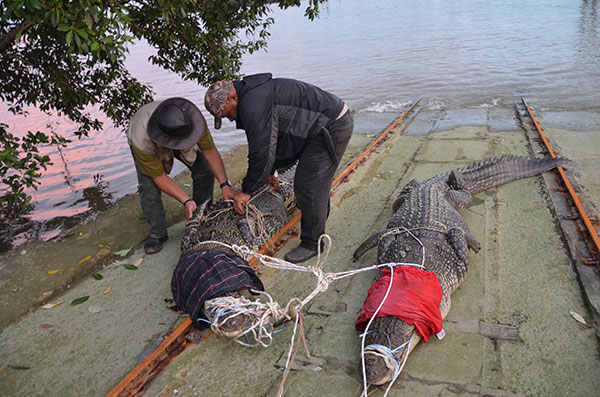
Securing the crocodiles.
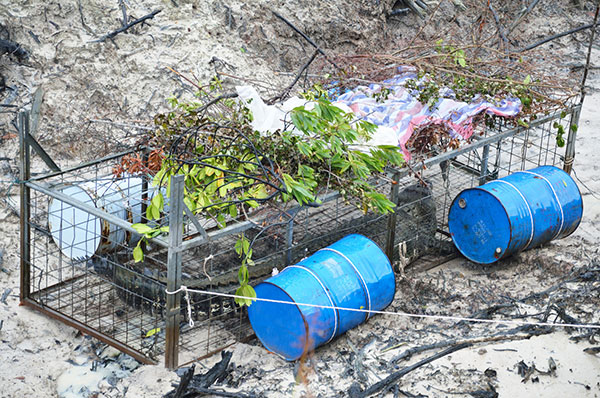
A crocodile caught in a cage.
SHE could only watch in horror as her father was devoured by a crocodile right in front of her eyes.
The girl, only 11 years old at the time, was standing at the riverbank with her younger brother while their father was inside the boat checking his fishing nets.
“My father screamed in pain and disappeared under the water in a matter of seconds. I saw his arms flailing above his head but he didn’t even have time to shout for help,” the young girl was quoted as saying.
In another part of Sarawak, a villager, in his early 30’s, was reportedly tossed three times into the air before being dragged under by a crocodile in a horrific attack. The victim was collecting wild fruits, known locally as buah pedada, with two friends at the time of the attack. He was standing waist-deep in the river while the friends climbed up a tree to pick the fruits. Before he was dragged to the middle of the river, he screamed for help.
These two incidents are among a slew of crocodile attack stories reported last year.
Imagine how a hungry crocodile snares its prey. From the NatGeo Wild Channel, you can see the stealthy reptile pouncing on unwary game, snatching it in its jaws, then doing the death roll before making a feast of its quarry. That is how a crocodile attack humans as well. With formidable jaws, it can snap human bones like twigs.
Each time a crocodile attacks a person, the media would paint the reptile as a fearsome aggressive beast that seeks out unsuspecting victims. Among the headlines of crocodile attacks in Sarawak over the past one year or so are — ‘Killer croc devours fisherman’, ‘Man injured in Sungai Sarawak crocodile attack’ and ‘Villager feared dead in croc attack’.
These are enough to put you off ever coming close to the habitats of the reptilian predators. But for many people, the risk of being attacked is part of everyday life. That crocodiles are dangerous is all too real but like many things in nature, there is always more to it than meets the eye.
Crocodiles do not necessarily set out to hunt humans. They are clearly ferocious hunters but are opportunistic predators.
The plight of the estuarine crocodiles in Sarawak was so serious in the 1980’s that they were threatened with extinction. But thanks to protection under the law and the ensuing conservation management by the Sarawak Forestry Corporation (SFC), the crocodile population has recovered in many of their habitats.
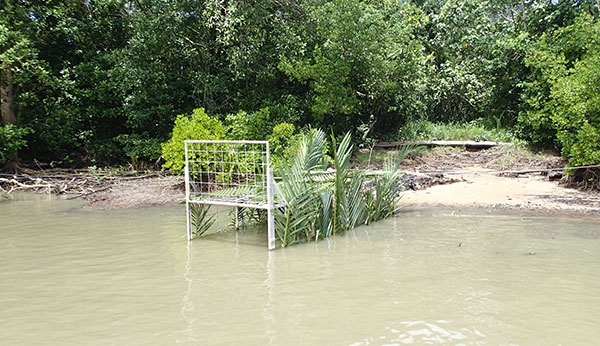
A camouflaged cage placed near the riverbank to trap crocodiles.
Human-croc conflicts
However, with the recovery, new problems have surfaced, particularly human-croc conflicts. The conservation problem maybe solved but it has also brought about a management problem that requires different solutions.
Crocodiles generally suffer from bad press. Although revered in some communities, they are seen mainly as vicious and ravenous man-eaters. The mere mention of crocodiles evokes a lot of negative emotions and sentiments.
Crocodile-human conflicts, especially attacks on humans that result in deaths and serious injuries, conjure up highly emotive reactions — for example, calling for the elimination of crocodiles.
Early this year, there were two crocodile attacks within a space of one week at Santubong and Tupong near Kuching, sparking a public outcry to do something about the increasing crocodile population. Concerned about the situation, Chief Minister Datuk Patinggi Tan Sri Adenan Satem has directed SFC to step up culling in the state.
What does it take to execute culling? Is it the act of exterminating the crocodiles at the location or the river where the attacks occurred?
According to an SFC press statement, culling is not simply going into crocodile territory with guns blazing and hoping to kill the ‘problem crocs’ or summarily, all the crocodiles.
The corporation explained culling is part of a scientific process in conservation management and a deliberate process carried out to maintain equilibrium in the population dynamics of a species and mitigate issues such as human-wildlife conflicts.
In Sarawak, it said, culling in crocodile conservation management referred to the process of removing or killing crocodiles that attacked humans, or crocodiles deemed to be potential dangers to humans in the Crocodile Removal Zone (CRZ) or other crocodile habitats. Culling operations in the latter are preceded by continuous monitoring of the crocodile population.
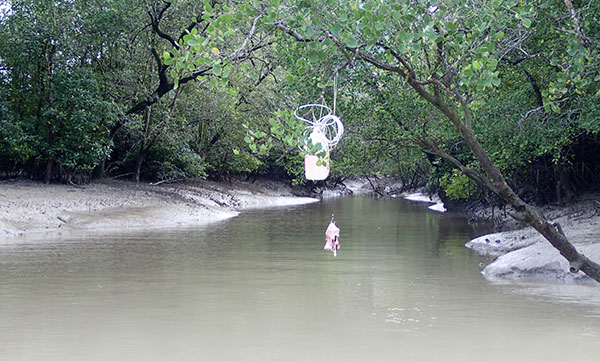
Baited hook and line attached on a tree branch to snare crocodiles.
Urgent culling operation
Following the Satubong attack in January this year, SFC said it conducted an urgent operation to cull the “guilty” crocodiles from 18 to 26 of the said month, starting with a swift survey of the habitats where the attacks occurred.
During the survey, appropriate locations (riverbanks) were identified for setting live traps and the hooks and lines over a distance of 2km or so upstream and downstream. The radius of a mature crocodile’s territorial range is about 2km. And once baited, the traps and hooks would be monitored everyday. New baits would be placed if the previous ones had been taken.
Unfortunately, the operation at Santubong did not yield any success in culling any of the targeted crocodiles. This was attributed to the reptiles being wary of the sudden bustle of post-attack activities from the search and rescue operations as well as the noise and vibrations from curious rubber-necking crowds and the motorised assets deployed.
The SFC carried out a second culling in the last week of February after the initial panic over the two previous attacks had simmered down. The operation involved the use of guns which is difficult to follow through because of various factors such as the presence of people in the vicinity and the need for optimum conditions for a shot to be fired to score a kill. Three crocodiles were culled during the operation.
SFC’s Swift Wildlife Action Team also carried out culling in the waters from the Satok Bridge to the Kuching Barrage, covering areas, including Tupong where a crocodile attack occurred recently. During the operation from Feb 19 and 22, four crocodiles were culled.
According to the SFC statement, cullings were carried out in Kuching, Samarahan, Sri Aman, Sarikei, Sibu, Miri and Limbang Divisions over the past three years — 2013 to 2015. There were 16 cullings in 2013, 13 in 2014 and 22 in 2015. A total of 41 ‘problem crocodiles’ were taken out from the various locations.
While culling is one of the activities on the crocodile conservation agenda, there are other initiatives the government has taken to prevent an explosion of the reptiles’ population.
These include the 3M Buaya programme or the Communications, Education and Public Awareness Programme, and the proposal to down-list the estuarine crocodile (Crocodylus porosus) from Appendix I to Appendix II of the Convention on International Trade in Endangered Species of Wild Fauna and Flora (Cites). This will enable Sarawak to carry out sustainable harvests of the species.
SFC believes when the local communities realise the economic benefits accruing from crocodile conservation, they will be otivated to support the cause.
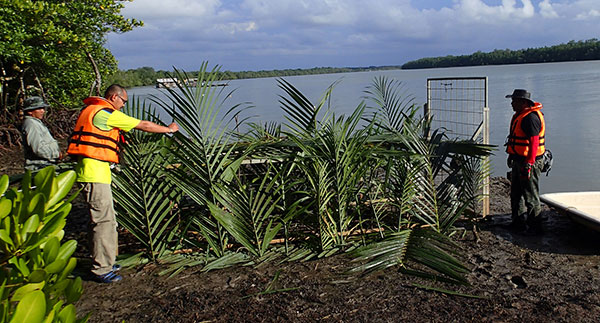
Setting up a camouflaged cage on the riverbank.
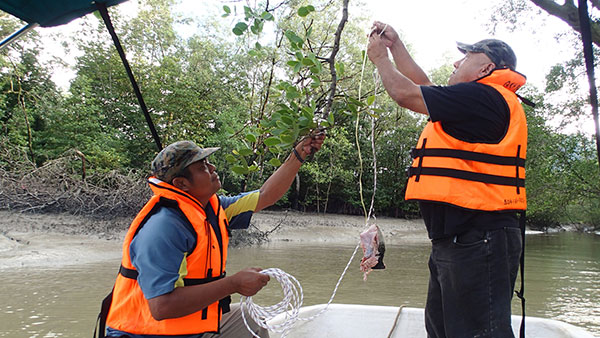
Setting up baited hook & line.
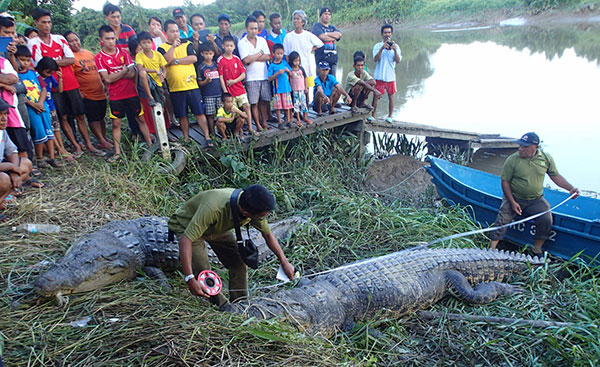
The Samarahan operation in 2015.
